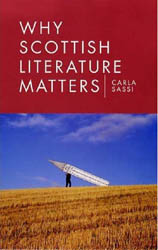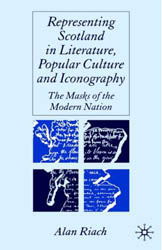Alan Riach
Style and Substance: A Deeper Look at Scottish Literature
The outsider often sees things differently. From a standpoint rooted in the European critical tradition, the Italian scholar and critic Carla Sassi offers new, refreshing insights into the nature of nationhood and identity as represented in and through Scottish literature from the earliest times to the present day.
 In his introduction to Sassi’s study, the poet Colin Donati writes that ‘few nations debate why their literature matters since the value and significance attaching to the national character of a canon of works is generally taken as read.’ Donati adds, ‘on the face of it, the Scots have no grounds for cultural insecurity in the matter of literature’, and ‘nobody seriously denies that there is a Scottish literature … yet the premise has not always been routinely assumed to hold’. Sassi takes as her starting-point the ‘paradoxical predicament’ of Scottish literature and the ‘many inevitable and insoluble contradictions’ that run through the debates surrounding the definition of Scottish literature and the canonical works. Some of the anomalies surrounding the ‘predicament’, Sassi outlines briefly: the lack of confidence that results from the colonisation or marginalisation to which smaller countries or regions have been subjected; the resultant difficulties of ethnic and linguistic fragmentation; and the fuzzy status of the ‘non-nation state’, which Scotland undeniably still is. These anomalies, argues Sassi, have contributed to the difficulties that Scotland has had, until recent times, in ‘defin[ing] itself in the clear-cut, exclusive terms required by literary critics and cultural historians’. Indeed, one of Sassi’s arguments is that ‘the failure to achieve a unitary, organic definition of its identity has weighed on twentieth century intellectuals as much as other, more obviously adverse historical conditions – in fact, it came to be identified by many Scottish intellectuals with the failure of their culture tout court.’
In his introduction to Sassi’s study, the poet Colin Donati writes that ‘few nations debate why their literature matters since the value and significance attaching to the national character of a canon of works is generally taken as read.’ Donati adds, ‘on the face of it, the Scots have no grounds for cultural insecurity in the matter of literature’, and ‘nobody seriously denies that there is a Scottish literature … yet the premise has not always been routinely assumed to hold’. Sassi takes as her starting-point the ‘paradoxical predicament’ of Scottish literature and the ‘many inevitable and insoluble contradictions’ that run through the debates surrounding the definition of Scottish literature and the canonical works. Some of the anomalies surrounding the ‘predicament’, Sassi outlines briefly: the lack of confidence that results from the colonisation or marginalisation to which smaller countries or regions have been subjected; the resultant difficulties of ethnic and linguistic fragmentation; and the fuzzy status of the ‘non-nation state’, which Scotland undeniably still is. These anomalies, argues Sassi, have contributed to the difficulties that Scotland has had, until recent times, in ‘defin[ing] itself in the clear-cut, exclusive terms required by literary critics and cultural historians’. Indeed, one of Sassi’s arguments is that ‘the failure to achieve a unitary, organic definition of its identity has weighed on twentieth century intellectuals as much as other, more obviously adverse historical conditions – in fact, it came to be identified by many Scottish intellectuals with the failure of their culture tout court.’
After the initial exposition of these anomalies, Sassi in the following eight brief chapters explores ‘this vast and extremely challenging subject’ and unravels Scotland’s ‘uniquely problematised heritage’ as it relates to the ‘equally problematic ideas’ of nation and identity. As one would very much expect of any literary history, these chapters naturally include discussions of ‘the Scotlands of the past’; ‘the dislocations and relocations’ of the eighteenth century; the ‘re-invention’ of Scotland in the following century; and the literary Renaissance of the twentieth. But it is good to say that Sassi’s is not ‘just another history of Scottish literature’. This is because she brings fresh perspectives to the subject, particularly in the later chapters, where ‘unfamiliar sights begin to appear on the road’. Here, Sassi concentrates on how some contemporary Scottish writers have moved away from or even beyond the perennial question of ‘definitions’ of nation and identity to ‘redefinitions’. Though Sassi is not the first cultural or literary critic to have noticed this shift, she takes the debate into new territory when she asks whether this shift of emphasis proclaims ‘a distinctively Scottish contribution to the re-definition of identity’ where ‘the problematisation of national identity has, inevitably, encouraged the questioning of wider identity issues’.
It was Robert Louis Stevenson, who wrote in 1883, that ‘Scotland is indefinable, it has no unity except upon the map’. Sassi argues that it is ‘this idea of indefinability that goes hand in hand with the increasing loosening of the relationship between the national space and identity which has characterised the second half of the twentieth century in many European countries. Scotland, in this respect, is no exception.’ An un-apologetically slim volume, Sassi’s insightful study takes an imaginative and refreshing approach to Scottish literature in a post-modern age and provides a useful and highly readable contribution to Scottish literary studies.
 In Representing Scotland in Literature, Popular Culture and Iconography, Alan Riach extends his sights to include a critical consideration of visual art, music, theatre, film, television and comics alongside canonical literary texts. The result is admittedly something of a tour de force, but also something of a disappointment. Encyclopaedic as Riach’s knowledge is, and impressively wide his cultural sympathies, the essays that make up this book do not seem to flow into each other or make any cohesive, or coherent, argument. This is a pity, as Alan Riach does have many interesting and perceptive comments to make, and though he writes with great erudition and passion about Scottish literature and culture, these essays have in effect been cobbled together, from ‘work that has appeared in earlier forms in various journals, in the form of conference papers, in discussions with individuals and in classes in universities in New Zealand, Scotland and elsewhere’, without any seeming cohesion.
In Representing Scotland in Literature, Popular Culture and Iconography, Alan Riach extends his sights to include a critical consideration of visual art, music, theatre, film, television and comics alongside canonical literary texts. The result is admittedly something of a tour de force, but also something of a disappointment. Encyclopaedic as Riach’s knowledge is, and impressively wide his cultural sympathies, the essays that make up this book do not seem to flow into each other or make any cohesive, or coherent, argument. This is a pity, as Alan Riach does have many interesting and perceptive comments to make, and though he writes with great erudition and passion about Scottish literature and culture, these essays have in effect been cobbled together, from ‘work that has appeared in earlier forms in various journals, in the form of conference papers, in discussions with individuals and in classes in universities in New Zealand, Scotland and elsewhere’, without any seeming cohesion.
In this over-ambitious study, Riach takes as his starting-point the premise that ‘the cultural production of Scotland has been weighted gravitationally towards a democratic idea of what ”the popular” – and what people – might be’, and that despite the increasing pressure to move away from the generalist, democratic base, the cultural tendency is still to ‘connect all specialisms with a social world of egalitarian possibility’. Accepting that this generalisation might be described at times as mythic, Riach argues that ‘it also reflects a deep idealism’ that can be seen in such beliefs and attitudes as ‘a crucial respect for education as a birthright and a sympathy with the common human needs and the unpredictable potential any individual has’. He writes that ‘popular understanding’ within ‘this world of egalitarian possibility’ is ‘geared towards an immediate recognition of certain symbols or cultural icons which offer the stability and the reassurance of conservative continuities across time and especially through times of political upheaval. These icons can serve more than one political purpose, from reactionary conservatism to progressive futurism, and Scotland is peculiarly rich in them.’
These icons, or ‘Scotland’s masks’ as Riach describes them, indicate the ‘representation of relations that present themselves as ways and forms in which relations are expressed and revealed, rather than things that conceal an irreducible national identity’. Quoting Charles Olson’s ‘form is never more than an extension of content’, Riach wonders if, across the genres of cultural production, it is always ‘never more than
…?’ Not that he proposes to examine or analyse every existing genre, and thankfully we are reassured when he writes, ‘if the selection of texts I have made is intended to represent certain aspects of the evolution of Scottish cultural production, I should emphasise that Representing Scotland is not and could not be comprehensive’.
And this is where one of the book’s problems lies: though Riach in his critical study systematically considers a great number of genres and numerous individual ‘texts’ within each genre, and explores these ‘forms in which aspects of Scotland’s identity have found expression’, he seems to have set his sights too wide, and simply does not do full justice to the multi-numerous cultural productions in his purview.
Ostensibly a hugely learned work, and a study that could be said to be, in its own way, sui generis, overall Representing Scotland in Literature, Popular Culture and Iconography does not really achieve what it sets out to do.
Why Scottish Literature Matters, Carla Sassi. Saltire Society. (ISBN 0824110828 PBK £11.98); Representing Scotland in Literature, Popular Culture and Iconography: The Masks of a Modern Nation, Alan Riach. Palgrave Macmillan (ISBN 1403945918 HBK £64)
© Michael Lister 2006

Comments